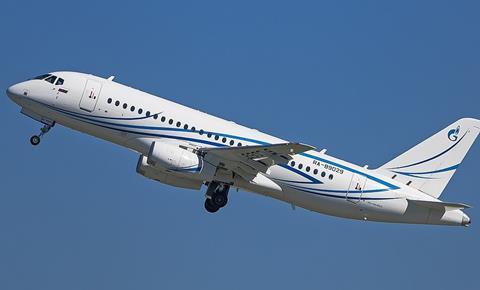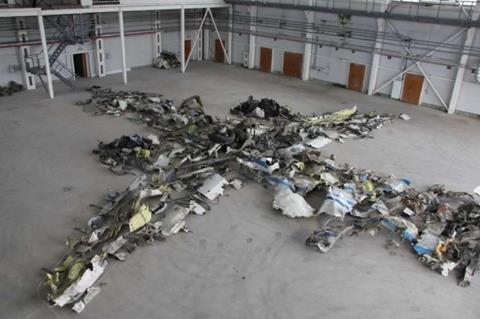Unambiguous procedures for installing angle-of-attack sensors on Yakovlev Superjet 100s are being developed after the fatal crash of a Gazpromavia aircraft – as well as an earlier incident involving a sister ship.
Russia’s Interstate Aviation Committee has disclosed the urgent measures in its preliminary findings into the 12 July accident, which occurred about 6min after the aircraft took off from Lukhovitsy during a ferry flight to Moscow Vnukovo.
As the jet’s flaps were retracted it entered a dive when its automatic stall-protection systems attempted to counter a perceived high angle-of-attack.
Attempts by the pilots to arrest the descent were unsuccessful and the aircraft (RA-89049) crashed into a forest. None of the three occupants survived.
The twinjet had departed Lukhovitsy after undergoing about two months of maintenance work. This maintenance work included removing two angle-of-attack sensors, one on the captain’s side and one on the first officer’s.
These sensors were subsequently installed on another Gazpromavia Superjet (RA-89029) on 6 May, and the inquiry has revealed that this aircraft experienced its own angle-of-attack data anomalies as it took off on a ferry flight later the same day.
The anomalies included a sudden change of angle-of-attack figures as the aircraft passed the 60kt threshold while accelerating along the runway. As the aircraft lifted off the crew received alerts and, in response, switched the captain’s instruments to a back-up air data computer. The flight was completed safely.

Investigators state that the ill-fated RA-89049 was fitted with another pair of angle-of-attack sensors, from a third Gazpromavia aircraft (RA-89018), during its maintenance visit.
As the Superjet accelerated along Lukhovitsy Tretyakovo airport’s runway 10, with the first officer flying, it similarly recorded a sudden jump in angle-of-attack values as it passed 60kt – the two primary air data computers showed 3.8° and 4.8°, and these values synchronously increased as the aircraft lifted off.
The aircraft turned left to follow the departure pattern and climbed, under autopilot, to around 3,500ft before the crew started retracting the flaps.
When the flaps retracted from the ‘Flaps 2’ to ‘Flaps 1’ setting, the aircraft indicated an airspeed disagreement between the air-data systems, says the inquiry.
Shortly after the aircraft entered a left turn towards the west, at just under 5,000ft, the crew remarked on the air-data disagreement. But after confirming that one another’s primary displays showed similar airspeeds – 180kt and 190kt – the pilots continued with the flight.
At this point the aircraft was pitched 5-6° nose-up with the angle-of-attack sensors reading 10-11.5° and 11-13.5°.
As the crew prepared to enter a climb towards cruising altitude, they selected a 230kt target speed and the autothrottle commanded higher thrust.
The pilots then cleaned the configuration by fully retracting the flaps and placing the autopilot in ‘climb’ mode.
But the inquiry says the aircraft did not begin to climb because, almost simultaneously, the horizontal stabiliser began shifting towards a nose-down position.

The inquiry states that the Superjet has an angle-of-attack limiting function to protect the aircraft if it senses that the angle-of-attack has crossed a specific threshold – a threshold which depends on the aircraft’s configuration and speed.
It states that the nature of the recorded stabiliser and elevator changes “most likely” indicate that “at this stage of the flight, during the cleaning [of the flaps], conditions arose for the first activation of the [angle-of-attack limiter]”.
With the shift in the stabiliser, the aircraft’s pitch transitioned from 5° nose-up to 3.5° nose-down and it began to descend.
The first officer, realising the aircraft was losing altitude, pulled fully back on the sidestick which disengaged the autopilot.
Almost immediately, the captain took control of the aircraft.
The protection function limits the maximum angle-of-attack that can be obtained by pulling the sidestick.
This available angle-of-attack margin from the sidestick was “sufficient” to stop the aircraft descending as it reached 4,500ft and even enough to enter a “slight climb”, says the inquiry.

But it adds that, when the captain took over, the autothrottle was disconnected and the aircraft had started to accelerate from 270kt. Within 30s it was exceeding its maximum operational speed of 308kt, triggering overspeed warnings.
The pilots, who were busy trying to contact air traffic control and remarking on the high angle-of-attack, “did not discuss” the overspeed alarm, the inquiry adds.
If the Superjet reaches the limit of indicated speed, the system logic commands an increase in pitch and the automatic deployment of spoilers in order to slow the aircraft.
Spoiler release, however, led to a reduction in lift. The aircraft stopped its shallow climb at 4,800ft and began to descend again.
Activation of the spoilers also generated a pitching moment which tended to increase the angle-of-attack. The angle-of-attack protection function continued to limit the effect of the crew’s pulling back on their sidesticks and the elevators instead deflected downwards as the protection system countered the pitch-up moment.
Attempts to recover from the increasingly rapid descent by advancing and then retarding the thrust levers were unsuccessful. The captain’s sidestick was held fully back throughout the last 28s of the dive, the inquiry states, but the elevators remained deflected 6° down.
Ground-proximity warnings sounded at 3,800ft and the first officer pulled his sidestick fully back at 1,380ft, but the aircraft – pitched 25° nose-down and travelling at 365kt – struck the ground in a forested area about 1.5km west of the village of Apraksino, some 20km northwest of Lukhovitsy.
Investigation of the accident is continuing and the inquiry has yet to draw final conclusions, as it examines various aspects of the aircraft’s operation, system design, and maintenance.


























